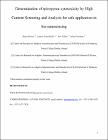| dc.contributor.author | GIORDANI, SILVIA | |
| dc.contributor.author | MOVIA, DANIA | |
| dc.contributor.author | VOLKOV, YURI | |
| dc.contributor.author | PRINA MELLO, ADRIELE | |
| dc.date.accessioned | 2020-07-30T16:42:45Z | |
| dc.date.available | 2020-07-30T16:42:45Z | |
| dc.date.issued | 2010 | |
| dc.date.submitted | 2010 | en |
| dc.identifier.citation | Movia, D., Prina-Mello, A., Volkov, Y., Giordani, S, Determination of spiropyran cytotoxicity by high content screening and analysis for safe application in bionanosensing, Chemical Research in Toxicology, 2010, 23, 9, 1459 - 1466 | en |
| dc.identifier.other | Y | |
| dc.identifier.uri | http://hdl.handle.net/2262/93088 | |
| dc.description | PUBLISHED | en |
| dc.description.abstract | The in vitro toxic response of spiropyrans in cellular models has not been previously addressed, despite the fact that such photoswitchable molecules have shown great potential as versatile and tunable components for bionanodevices and imaging agents. In this study, we examine the cytotoxic effects of a spiropyran, namely, 8-methoxy-6-nitro-BIPS (1′,3′-dihydro-1′-ethanol-3′,3′-dimethyl-8-methoxy-6-nitro-spiro(2H-1-benzopyran-2,2′-(2H)-indole) [1], in three cultured cellular models (THP-1, AGS, and A549 cell lines) by High Content Screening and Analysis (HCSA) and by enzyme-linked immunosorbent (ELISA) assays (Interleukin-6 and Tumor Necrosis Factor-alpha). The HCSA results show that low concentrations of 8-methoxy-6-nitro-BIPS (10−6, 10−8, and 10−9 M) do not induce any cytotoxic response after 24 and 72 h exposure time, while at the highest concentrations (10−3and 10−4 M) the exposure time becomes a critical parameter of the toxic response. The cell viability is reduced by 60% for THP-1 cells, 50% for AGS cells, and 40% for A549 cells at a spiropyran concentration of 10−3 M after 24 h incubation, whereas at 72 h, the cell loss increases above 90%. Interestingly, at 10−4 M no significant cytotoxic response is registered after 24 h exposure, where contrarily cytotoxicity is verified after 72 h. Our ELISA results show that consistently with the HCSA analysis a robust inflammatory response is present at 10−3 M after 24 h exposure and at 10−3 M and 10−4 M after 72 h, in all three cell lines investigated. | en |
| dc.description.sponsorship | This work was supported by Science Foundation Ireland under different schemes (PIYRA 07/Y12/I1052, CSET and SRC), Higher Education Authority (HEA) under the PRTLI-4 programme, the Health Research Board and IRCSET (Postgraduate Research Scholarship to Dania Movia). We are grateful to Dr Despina Bazou for the live imaging, Mr Antoin Douglawi and Mr Manuel Natali for the synthesis of the spiropyran. We also would like to thank Ms Fiona Byrne, Dr
15
Anthony Mitchell, Dr Bashir Mohammed (TCD-HCSA laboratory) for the technical support and the helpful advice and discussions. | en |
| dc.format.extent | 1459 | en |
| dc.format.extent | 1466 | en |
| dc.language.iso | en | en |
| dc.relation.ispartofseries | Chemical Research in Toxicology; | |
| dc.relation.ispartofseries | 23; | |
| dc.relation.ispartofseries | 9; | |
| dc.rights | Y | en |
| dc.subject | AGS, human gastric cancer cell line; A549, human adenocarcinomic | en |
| dc.subject.lcsh | AGS, human gastric cancer cell line; A549, human adenocarcinomic | en |
| dc.title | Determination of spiropyran cytotoxicity by high content screening and analysis for safe application in bionanosensing | en |
| dc.type | Journal Article | en |
| dc.type.supercollection | scholarly_publications | en |
| dc.type.supercollection | refereed_publications | en |
| dc.identifier.peoplefinderurl | http://people.tcd.ie/giordans | |
| dc.identifier.peoplefinderurl | http://people.tcd.ie/yvolkov | |
| dc.identifier.peoplefinderurl | http://people.tcd.ie/prinamea | |
| dc.identifier.peoplefinderurl | http://people.tcd.ie/dmovia | |
| dc.identifier.rssinternalid | 69090 | |
| dc.identifier.doi | 10.1021/tx100123g | |
| dc.subject.TCDTheme | Nanoscience & Materials | en |
| dc.subject.TCDTheme | Next Generation Medical Devices | en |
| dc.subject.TCDTag | Medical Devices | en |
| dc.identifier.rssuri | http://dx.doi.org/10.1021/tx100123g | |




